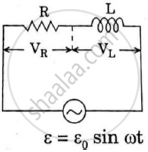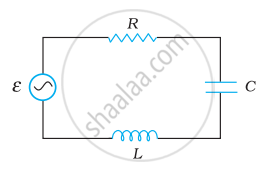Advertisements
Advertisements
प्रश्न
An LR circuit having a time constant of 50 ms is connected with an ideal battery of emf ε. find the time elapsed before (a) the current reaches half its maximum value, (b) the power dissipated in heat reaches half its maximum value and (c) the magnetic field energy stored in the circuit reaches half its maximum value.
उत्तर
Given:-
Time constant of the LR circuit = 50 ms
Emf of the battery = ε
The time constant of the LR circuit is given by
\[\tau = \frac{L}{R} = 50 ms = 0 . 05 s\]
Let the current reach half of its maximum value in time t.
Now,
\[\frac{i_0}{2} = i_0 (1 - e^{- t/0 . 05} )\]
\[ \Rightarrow \frac{1}{2} = 1 - e^{- t/0 . 05} \]
\[ \Rightarrow e^{- t/0 . 03} = \frac{1}{2}\]
On taking natural logarithm (ln) on both sides, we get
\[\ln e^{- t/0 . 05} = \ln\left( \frac{1}{2} \right)\]
\[ \Rightarrow - \frac{t}{0 . 05} = \ln(1) - \ln(2)\]
\[ \Rightarrow - \frac{t}{0 . 05} = 0 - 0.6931\]
\[ \Rightarrow t = 0 . 05 \times 0 . 6931\]
\[ = 0 . 03465 s\]
\[ = 35 ms\]
(b) Let t be the time at which the power dissipated is half its maximum value.
Maximum power = `E^2/R`
\[\therefore \frac{E^2}{2R} = \frac{E^2}{R}(1 - e^{tR/L} )^2 \]
\[ \Rightarrow 1 - e^{- R/L} = \frac{1}{\sqrt{2}} = 0 . 707\]
\[ \Rightarrow e^{- tR/L} = 0 . 293\]
\[ \Rightarrow t = 50 \times 1 . 2275 ms\]
\[ = 61 . 2 ms\]
(c) Current in the coil at the steady state, `i = epsilon/R`
Magnetic field energy stored at the steady state,
\[U = \frac{1}{2}L i^2\text{ or }U\]
\[= \frac{\epsilon^2}{2 R^2}L\]
Half of the value of the steady-state energy = \[\frac{1}{4}L\frac{\epsilon^2}{R^2}\]
Now,
\[\frac{1}{4}L\frac{\epsilon^2}{R^2} = \frac{1}{2}L\frac{\epsilon^2}{R^2}(1 - e^{- tR/L} )^2 \]
\[ \Rightarrow e^{- tR/L} = \frac{\sqrt{2} - 1}{\sqrt{2}} = \frac{2 - \sqrt{2}}{2}\]
\[ \Rightarrow t = \tau\left[ \ln\left( \frac{1}{2 - \sqrt{2}} \right) + \ln 2 \right]\]
\[= 0 . 05\left[ \ln\left( \frac{1}{2 - \sqrt{2}} \right) + \ln 2 \right]\]
\[= 0 . 061 s\]
\[= 61 ms\]
APPEARS IN
संबंधित प्रश्न
In a series LCR circuit, obtain the condition under which the impedance of the circuit is minimum ?
An L-R circuit has L = 1.0 H and R = 20 Ω. It is connected across an emf of 2.0 V at t = 0. Find di/dt at (a) t = 100 ms, (b) t = 200 ms and (c) t = 1.0 s.
The magnetic field at a point inside a 2.0 mH inductor-coil becomes 0.80 of its maximum value in 20 µs when the inductor is joined to a battery. Find the resistance of the circuit.
What will be the potential difference in the circuit when direct current is passed through the circuit?

Draw a labelled graph showing a variation of impedance of a series LCR circuit with frequency of the a.c. supply.
Choose the correct answer from given options
The selectivity of a series LCR a.c. circuit is large, when
Figure shows a series LCR circuit connected to a variable frequency 230 V source. L = 5.0 H, C = 80 µF, R = 40 Ω.

- Determine the source frequency which drives the circuit in resonance.
- Obtain the impedance of the circuit and the amplitude of current at the resonating frequency.
- Determine the rms potential drops across the three elements of the circuit. Show that the potential drop across the LC combination is zero at the resonating frequency.
A series LCR circuit with L = 0.12 H, C = 480 nF, R = 23 Ω is connected to a 230 V variable frequency supply.
(a) What is the source frequency for which current amplitude is maximum. Obtain this maximum value.
(b) What is the source frequency for which average power absorbed by the circuit is maximum. Obtain the value of this maximum power.
(c) For which frequencies of the source is the power transferred to the circuit half the power at resonant frequency? What is the current amplitude at these frequencies?
(d) What is the Q-factor of the given circuit?
In a series LCR circuit supplied with AC, ______.
Assertion: When the frequency of the AC source in an LCR circuit equals the resonant frequency, the reactance of the circuit is zero, and so there is no current through the inductor or the capacitor.
Reason: The net current in the inductor and capacitor is zero.
In a series LCR circuit the voltage across an inductor, capacitor and resistor are 20 V, 20 V and 40 V respectively. The phase difference between the applied voltage and the current in the circuit is ______.
At resonant frequency the current amplitude in series LCR circuit is ______.
A series LCR circuit contains inductance 5 mH, capacitance 2µF and resistance ion. If a frequency A.C. source is varied, what is the frequency at which maximum power is dissipated?
Which of the following components of an LCR circuit, with a.c. supply, dissipates energy?
A series LCR circuit containing a 5.0 H inductor, 80 µF capacitors, and 40 Ω resistor is connected to a 230 V variable frequency ac source. The angular frequencies of the source at which power is transferred to the circuit are half the power at the resonant angular frequency are likely to be ______.
A coil of 0.01 henry inductance and 1 ohm resistance is connected to 200 volt, 50 Hz ac supply. Find the impedance of the circuit and time lag between max. alternating voltage and current.
A series LCR circuit driven by 300 V at a frequency of 50 Hz contains a resistance R = 3 kΩ, an inductor of inductive reactance XL = 250 πΩ, and an unknown capacitor. The value of capacitance to maximize the average power should be ______.
